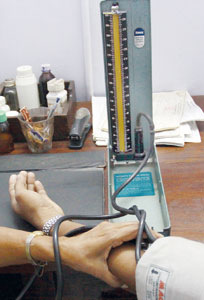It is one of the principal vital signs, yet high blood pressure often goes unnoticed. It has been associated with a number of serious medical conditions, so it’s essential that the ‘silent killer’ is caught early and managed carefully. This week, MediScene speaks with Dr. Prasad Katulanda, Consultant Endocrinologist, on the risk associated with high blood pressure and what you can do to manage it. “It’s becoming a common condition,” says Dr. Katulanda, explaining that as much as 27% of the Sri Lankan population might be affected by it.
As your blood pounds through your body, it pushes against the walls of your arteries with each heart beat. Typically, blood pressure rises and falls naturally, and is different throughout the day. “Usually at night, when you’re sleeping, blood pressure is lowest,” says Dr. Katulanda. Unfortunately, if it stays high over a long of period of time, it can wreak havoc with your body, significantly increasing your risk of heart attack, heart failure, stroke, kidney failure, among other health problems, he says. That most people maintain a normal blood pressure is the result of the painstaking balancing act undertaken by the autonomic nervous system, which uses a complex network of receptors, nerves, and hormones to accomplish its task.
 |
However, when blood pressure first rises, there are usually no obvious symptoms, and many people have gone for years without a diagnosis. It’s why doctors suggest you check your blood pressure even when you’re feeling fine. “Fit, young people can check once a year, but when it comes to someone with high blood pressure, depending upon the level of control and your doctor’s advice, you might have to check monthly or even weekly,” he cautions. Make sure you check your blood pressure whenever you see a doctor. Prevention or at least early intervention will ensure you live a healthier life.
When your blood pressure is measured, your results are given to you in the form of two numbers. They are your systolic and diastolic pressures. The former refers to your blood pressure when your heart is pumping and the second to when it is at rest between beats. Typically the systolic number is placed above or given before the diastolic number, such as 120/80 mmHg. (The mmHg is blood pressure measured in millimetres of mercury.) These are typically taken from a measurement of the blood pressure at the brachial artery – a major blood vessel in the upper arm that carries blood away from the heart.
Hypertension:
If you have been diagnosed with hypertension, it means simply that your heart has to work harder than it should to send blood pumping throughout your body. Cases of hypertension are classified either as primary hypertension or secondary hypertension, explains Dr. Katulanda. In primary hypertension, often no obvious medical cause can be found and these constitute the vast majority of cases. However, a minority of cases, dubbed secondary hypertension can be traced back to problems that affect organs like the kidneys, arteries, heart or endocrine system. Doctors approach the treatment of secondary hypertension differently – dealing with underlying condition that manifests in the high blood pressure.
Though the causes of primary hypertension remain a mystery, risk factors such as a sedentary or stressful lifestyle, smoking (women who are over 35 and older who smoke cigarettes are at even greater risk for heart disease and stroke and should seriously consider quitting), alcoholism, obesity and certain deficiencies have been known to contribute to it. Risk also increases with aging, particularly for those who belong to families with a history of hypertension, he says. In pregnant women, hypertension is considered a symptom of pre-eclampsia, which when it progresses into eclampsia can result in dangerous complications for both mother and child. Common symptoms are the appearance of protein in the urine, generalized swelling, and severe seizures.
In general, hypertension, when it persists is one of the most potent high risk factors contributing to strokes and heart disease and is a leading cause of chronic kidney failure. Even when not so severe, it has an adverse impact on life expectancy.
A significant number of people with diabetes also struggle with high blood pressure. For them, this is a well known risk factor associated with diabetes related complications such as diabetic eye disease and kidney disease.
In addition, many diabetics find that they have developed the condition known as atherosclerosis (cholesterol deposition and hardening of the arteries) earlier than non-diabetic people, which in turn can cause high blood pressure. If left untreated, this can lead to blood vessel damage, heart attack, stroke, heart failure, or kidney failure.
The good news, says Dr. Katulanda, is that consistent dietary and lifestyle changes can significantly improve blood pressure control and drug treatments are also available.
Managing your blood pressure:
You can bring your blood sugar under control, and as you’ve seen, it’s crucial that you do. Ideally, a blood pressure below 120/80 is what you should aspire to; however, patients with conditions such as diabetes and kidney disease should keep an even tighter rein on their pressure. Begin by adopting healthy lifestyle habits and your doctor will prescribe medications in addition, if you need them.
Dr. Katulanda emphasises that the key points are maintaining a healthy weight, adopting a regular exercise schedule, eating a diet rich in fruits and vegetables, and opting for low fat dairy foods. Cutting down on salt is a must, and he also recommends reducing coffee intake and if you’re a drinker, cutting down on alcohol intake.
Classification of blood pressure for adults |
BLOOD PRESSURE CLASSIFICATION |
SBP MMHG |
DBP MMHG
|
| Normal |
<120 |
and <80 |
| Prehypertension |
120-139 |
or 80-89 |
Stage 1 -
Hypertension |
140-159 |
or 90-99 |
| Stage 2 -
Hypertension |
≥160 |
or ≥100 |
|
